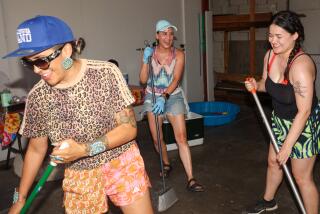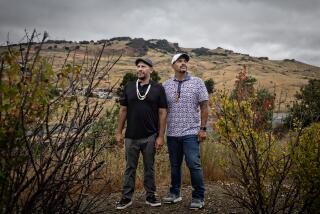Keeping the Sacred Circle : Representatives of About 30 Tribes Are Holding a Powwow at Cal State Fullerton
- Share via
FULLERTON — Through ancient ceremonial dance, Saginaw Grant told stories about hunting expeditions, celebrations and battles Saturday at Cal State Fullerton.
“This next dance tells about my past adventures,” said Grant, a 60-year-old member of the Sauk-Fox tribe, during a break between performances. “All these dances tell a story. We’re not just jumping and hollering out here. We’re telling about events, about combat, about family traditions, about people and about what we would like to see on Mother Earth. These are sacred prayers.”
Grant was representing one of about 30 tribes participating in the university’s fourth annual powwow, organized by Cal State Fullerton’s Inter-Tribal Student Council. The event concludes tonight and is expected to draw more than 1,000 observers.
Organizers said the powwow brings together Native Americans from throughout the country to celebrate their heritage while educating the public.
“This is a good day,” said Phyllis Big Left Hand, 53, a Cheyenne medicine woman. “I feel a lot of inspiration and spirituality as the first Americans of this land come together here to share with all other creeds, colors and races. This is what I call unity.”
Si Nguyen, 48, of San Gabriel said he attended the powwow to learn about Native American culture firsthand. “I always see them in the movies,” he said. “But today I found out more about them and their traditions. I’m enjoying it.”
For Native Americans, “this is where we pass on our traditions to our children,” said Daniel Tom, 46, who is Pomo Paiute. “There’s a lot of ceremony here.”
As the event commenced Saturday afternoon, dancers formed the sacred circle and danced to the beat of the drums. They were all ages and clad in colorful buckskin, beads, feathers, porcupine quill and deerskin moccasins. Their steps were slow for some dances and spirited and athletic for others.
Thomas Parilla, 43, an Apache, was the head male dancer of the Northern traditional style. He wore a breastplate made of buffalo bones and glass beads, an eagle feather bustle and fringed bells around his knees. “My dance will be thanking Mother Earth for what she has given us. It also is a warrior dance, and the warrior is the protector of the tribe and of the family.”
Eleven-year-old Laura Galban, of the Shoshone tribe, said she’s been dancing in powwows for as long as she can remember. “They let us know about our ancestors and where we come from--make us feel proud.”
That’s why Violet Little, of the San Carlos Apache tribe, said she attended the event with her children and grandchildren.
“This is the only connection that those who live in the white man’s world have to the reservations,” she said. “Powwows tell you about your identity and show the public that we, the American Indians, still are alive.”
Powwows typically last three days and nights and are held nearly every weekend somewhere in the nation from spring through fall. Participants bring their families. They sing, dance, socialize and get in touch with their roots.
Besides the dancing and drumming performances, vendors offered handcrafted items, including pipes, turquoise-and-silver jewelry and rabbit furs. Navaho tacos were served, and children got their faces painted.
“These things keep our traditions alive and our families strong,” Parilla said. “It’s good for our spirit, and it’s good for people to know that Indians are still around.”
More to Read
Sign up for Essential California
The most important California stories and recommendations in your inbox every morning.
You may occasionally receive promotional content from the Los Angeles Times.










